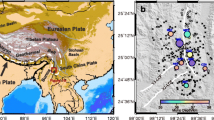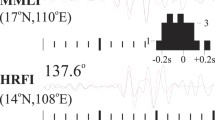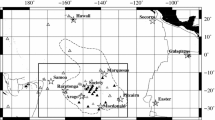Abstract
The fate of a subducted slab is a key ingredient in the context of plate tectonics, yet it remains enigmatic especially in terms of its crustal component. In this study, our efforts are devoted to resolve slab-related structures in the mid-mantle below eastern Indonesia, the Izu–Bonin region, and the Peru area by employing seismic array analysing techniques on high-frequency waveform data from F-net in Japan and the Alaska regional network and the USArray in North America. A pronounced arrival after the direct P wave is observed in the recordings of four deep earthquakes (depths greater than 400 km) from three subduction systems including the Philippines, the Izu–Bonin, and the Peru. This later arrival displays a slightly lower slowness compared to the direct P wave and its back-azimuth deviates somewhat from the great-circle direction. We explain it as an S-to-P conversion at a deep scatterer below the sources in the source region. In total, five scatterers are seen at depths ranging from ~930 to 1500 km. Those scatterers appear to be characterised by an ~7 km-thick low-velocity layer compared to the ambient mantle. Combined evidence from published mineral physical analysis suggests that past subducted oceanic crust, possibly fragmented, is most likely responsible for these thin-layer compositional heterogeneities trapped in the mid-mantle beneath the study regions. Our observations give a clue to the potential fate of subducted oceanic crust.








Similar content being viewed by others
References
Ballmer, M. D., Schmerr, N. C., Nakagawa, T., & Ritsema, J. (2015). Compositional mantle layering revealed by slab stagnation at 1000-km depth. Science Advances, 1(11), e1500815. https://doi.org/10.1126/sciadv.1500815.
Ballmer, M. D., Houser, C., Hernlund, J. W., Wentzcovitch, R. M., & Hirose, K. (2017). Persistence of strong silica-enriched domains in the Earth’s lower mantle. Nature Geoscience, 10(3), 236–240. https://doi.org/10.1038/NGEO2898.
Bentham, H., & Rost, S. (2014). Scattering beneath western Pacific subduction zones: evidence for oceanic crust in the mid-mantle. Geophysical Journal International, 197, 1627–1641.
Bentham, H. L. M., Rost, S., & Thorne, M. S. (2017). Fine-scale structure of the mid-mantle characterised by global stacks of PP precursors. Earth and Planetary Science Letters, 472, 164–173.
Castle, J. C., & Creager, K. C. (1999). A steeply dipping discontinuity in the lower mantle beneath Izu-Bonin. Journal of Geophysical Research: Solid Earth, 104(B4), 7279–7292.
Castle, J. C., & van der Hilst, R. D. (2003). Searching for seismic scattering off mantle interfaces between 800 km and 2000 km depth. Journal of Geophysical Research: Solid Earth, 108(B2), 2095. https://doi.org/10.1029/2001JB000286.
Courtier, A. M., & Revenaugh, J. (2008). Slabs and shear wave reflectors in the midmantle. Journal of Geophysical Research: Solid Earth, 113, B08312. https://doi.org/10.1029/2007JB005261.
Christensen, U. R., & Hofmann, A. W. (1994). Segregation of subducted oceanic crust in the convecting mantle. Journal of Geophysical Research: Solid Earth, 99(B10), 19867–19884.
Deuss, A., & Woodhouse, J. H. (2002). A systematic search for mantle discontinuities using SS-precursors. Geophysical Research Letters, 29(8), 1249. https://doi.org/10.1029/2002GL014768.
Dziewonski, A. M., & Woodhouse, J. H. (1987). Global images of the Earths interior. Science, 236, 37–48.
French, S. W., & Romanowicz, B. (2015). Broad plumes rooted at the base of the Earth’s mantle beneath major hotspots. Nature, 525, 95–99.
Fukao, Y., & Obayashi, M. (2013). Subducted slabs stagnant above, penetrating through, and trapped below the 660 km discontinuity. Journal of Geophysical Research: Solid Earth, 118(11), 5920–5938.
Gu, Y. J., Okeler, A., & Schultz, R. (2012). Tracking slabs beneath northwestern Pacific subduction zones. Earth and Planetary Science Letters, 331–332, 269–280. https://doi.org/10.1016/j.epsl.2012.03.023.
Hall, R. (2002). Cenozoic geological and plate tectonic evolution of SE Asia and the SW Pacific: computer-based reconstructions, model and animations. Journal of Asian Earth Sciences, 20, 353–434.
Hall, R., & Spakman, W. (2015). Mantle structure and tectonic history of SE Asia. Tectonophysics, 658, 14–45.
Hedlin, M. A. H., Shearer, P. M., & Earle, P. S. (1997). Seismic evidence for small-scale heterogeneity throughout the Earths mantle. Nature, 387, 145–150.
Helffrich, G. (2006). Heterogeneity in the mantle; its creation, evolution and destruction. Tectonophysics, 416(1–4), 23–31.
Hirose, K., Fei, Y., Ma, Y., & Mao, H.-K. (1999). The fate of subducted basaltic crust in the Earths lower mantle. Nature, 397, 53–56.
Hofmann, A. W. (1997). Mantle geochemistry: the message from oceanic volcanism. Nature, 385(6613), 219–229.
Irifune, T., & Ringwood, A. E. (1993). Phase transformations in subducted oceanic crust and buoyancy relationships at depths of 600–800 km in the mantle. Earth and Planetary Science Letters, 117, 101–110.
Jaxybulatov, K., Koulakov, I., & Dobretsov, N. L. (2013). Segmentation of the Izu-Bonin and Mariana slabs based on the analysis of the Benioff seismicity distribution and regional tomography results. Solid Earth, 4, 59–73. https://doi.org/10.5194/se-4-59-2013.
Jenkins, J., Deuss, A., & Cottaar, S. (2017). Converted phases from sharp 1000 km depth mid-mantle heterogeneity beneath Western Europe. Earth and Planetary Science Letters, 459, 196–207.
Justo, J. F., Morra, G., & Yuen, D. A. (2015). Viscosity undulations in the lower mantle: The dynamical role of iron spin transition. Earth and Planetary Science Letters, 421, 20–26.
Kaneshima, S. (2003). Small-scale heterogeneity at the top of the lower mantle around the Mariana slab. Earth and Planetary Science Letters, 209, 85–101.
Kaneshima, S. (2009). Seismic scatterers at the shallowest lower mantle beneath subducted slabs. Earth and Planetary Science Letters, 286, 304–315.
Kaneshima, S., & Helffrich, G. (2010). Small scale heterogeneity in the mid- lower mantle beneath the circum-Pacific area. Physics of the Earth and Planetary Interiors, 183, 91–103.
Kaneshima, S. (2016). Seismic scatterers in the mid-lower mantle. Physics of the Earth and Planetary Interiors, 257, 105–114.
Karato, S.-I. (1997). On the separation of crustal component from subducted oceanic lithosphere near the 660 km discontinuity. Physics of the Earth and Planetary Interiors, 99, 103–111.
Kawakatsu, H., & Niu, F. (1994). Seismic evidence for a 920-km discontinuity in the mantle. Nature, 371, 301–305.
Korenaga, J. (2015). Constraining the geometries of small-scale heterogeneities: A case study from the Mariana region. Journal of Geophysical Research: Solid Earth, 120(11), 7830–7851. https://doi.org/10.1002/2015JB012432.
Kennett, B. L. N., & Engdahl, E. R. (1991). Travel times for global earthquake location and phase identification. Geophysical Journal International, 105, 429–465.
Lee, C.-T. A., & Chen, W.-P. (2007). Possible density segregation of subducted oceanic lithosphere along a weak serpentinite layer and implications for compositional stratification of the Earth’s mantle. Earth and Planetary Science Letters, 255, 357–366.
Li, M., NcNamara, A. K., & Garnero, E. J. (2014). Chemical complexity of hotspots caused by cycling oceanic crust through mantle reservoirs. Nature Geoscience, 7, 366–370. https://doi.org/10.1038/ngeo2120.
Li, J., & Yuen, D. A. (2014). Mid-mantle heterogeneities associated with Izanagi plate: implications for regional mantle viscosity. Earth and Planetary Science Letters, 385, 137–144.
Li, Y.-Q., Ma, C.-Q., Robinson, P. T., Zhou, Q., & Liu, M.-L. (2015). Recycling of oceanic crust from a stagnant slab in the mantle transition zone: Evidence from Cenozoic continental basalts in Zhejiang Province, SE China. Lithos, 230, 146–165.
Mancinelli, N., & Shearer, P. (2016). Scattered energy from a rough core-mantle boundary modeled by a Monte Carlo seismic particle method: Application to PKKP precursors. Geophysical Research Letters, 43(15), 7963–7972. https://doi.org/10.1002/2016GL070286.
Marquardt, H., & Miyagi, L. (2015). Slab stagnation in the shallow lower mantle linked to an increase in mantle viscosity. Nature Geoscience, 8, 311–314. https://doi.org/10.1038/ngeo2393.
Niu, F., Kawakatsu, H., & Fukao, Y. (2003). Seismic evidence for a chemical heterogeneity in the midmantle: a strong and slightly dipping seismic reflector beneath the Mariana subduction zone. Journal of Geophysical Research: Solid Earth, 108, 1978–2012.
Niu, F. (2014). Distinct compositional thin layers at mid-mantle depths beneath northeast China revealed by the USArray. Earth and Planetary Science Letters, 402, 305–312.
Petersen, N., Gossler, J., Kind, R., Stammler, K., & Vinnik, L. (1993). Precursors to SS and structures of transition zone of the North-Western Pacific. Geophysical Research Letters, 20(4), 281–284.
Ren, Y., Stulzmann, E., van der Hilst, R. D., & Besse, J. (2007). Under- standing seismic heterogeneities in the lower mantle beneath the Americas from seismic tomography and plate tectonic history. Journal of Geophysical Research: Solid Earth, 112, B01302. https://doi.org/10.1029/2005JB004154.
Rost, S., & Thomas, C. (2002). Array seismology: methods and applications. Reviews of Geophysics, 40(3), 1008. https://doi.org/10.1029/2000RG000100.
Rost, S., Garnero, E. J., & Williams, Q. (2008). Seismic array detection of subducted oceanic crust in the lower mantle. Journal of Geophysical Research: Solid Earth, 113, B06303. https://doi.org/10.1029/2007JB005263.
Richards, M. A., & Davies, G. F. (1989). On the separation relatively buoyant components from subducted lithosphere. Geophysical Research Letters, 16(8), 831–834.
Rudolph, M. L., Lekić, V., & Lithgow-Bertelloni, C. (2015). Viscosity jump in Earth’s mid-mantle. Science, 350(6266), 1349–1352. https://doi.org/10.1126/science.aad1929.
Shahnas, M. H., Yuen, D. A., & Pysklywec, R. N. (2017). Mid-mantle heterogeneities and iron spin transition in the lower mantle: Implications for mid-mantle slab stagnation. Earth and Planetary Science Letters, 458, 293–304.
Shahnas, M. H., Pysklywec, R. N., Justo, J. F., & Yuen, D. A. (2017). Spin transition-induced anomalies in the lower mantle: implications for mid-mantle partial layering. Geophysical Journal International, 210, 765–773.
Shen, X., Yuan, X., & Li, X. (2014). A ubiquitous low-velocity layer at the base of the mantle transition zone. Geophysical Research Letters, 41, 836–842.
Tsuchiya, T. (2011). Elasticity of subducted basaltic crust at the lower mantle pressures: insights on the nature of deep mantle heterogeneity. Physics of the Earth and Planetary Interiors, 188, 142–149.
Vanacore, E., Niu, F., & Kawakatsu, H. (2006). Observations of the mid-mantle discontinuity beneath Indonesia from S to P converted waveforms. Geophysical Research Letters, 33, L04302. https://doi.org/10.1029/2005GL025106.
van Keken, P. E., Karato, S., & Yuen, D. A. (1996). Rheological control of oceanic crust separation in the transition zone. Geophysical Research Letters, 23(14), 1821–1824.
Wang, R. (1999). A simple orthonormalization method for stable and efficient computation of Greens functions. Bulletin of the Seismological Society of America, 89, 733–741.
Waszek, L., Thomas, C., & Deuss, A. (2015). PKP precursors: Implications for global scatterers. Geophysical Research Letters, 42(10), 3829–3838. https://doi.org/10.1002/2015GL063869.
Wessel, P., & Smith, W. H. F. (1995). New version of the generic mapping tools. Eos, Transactions American Geophysical Union, 76(33), 329. https://doi.org/10.1029/95EO00198.
Xu, W., Lithgow-Bertelloni, C., Stixrude, L., & Ritsema, J. (2008). The effect of bulk composition and temperature on mantle seismic structure. Earth and Planetary Science Letters, 275, 70–79.
Yang, Z., & He, X. (2015). Oceanic crust in the mid-mantle beneath West-Central Pacific subduction zones: Evidence from S to P converted waveforms. Geophysical Journal Internationa, 203(1), 541–547. https://doi.org/10.1093/gji/ggv314.
Acknowledgements
We gratefully acknowledge IRIS and F-net for making waveform data available. Figures were made with GMT (Wessel and Smith 1995) and GNUPLOT. We thank Prof. Wim Spakman (editor), Dr. Sebastian Rost, and three anonymous reviewers for the careful and constructive review comment. This work was supported by the National Science Foundation of China (Grants 91428309, 41761134051) and State Key Laboratory of Marine Geology, Tongji University (No. MGK1705).
Author information
Authors and Affiliations
Corresponding author
Electronic supplementary material
Below is the link to the electronic supplementary material.
Rights and permissions
About this article
Cite this article
He, X., Zheng, Y. S-to-P Conversions from Mid-mantle Slow Scatterers in Slab Regions: Observations of Deep/Stagnated Oceanic Crust?. Pure Appl. Geophys. 175, 2045–2055 (2018). https://doi.org/10.1007/s00024-017-1763-z
Received:
Revised:
Accepted:
Published:
Issue Date:
DOI: https://doi.org/10.1007/s00024-017-1763-z




